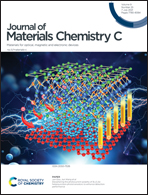Efficient carrier transport for 368 nm ultraviolet LEDs with a p-AlInGaN/AlGaN short-period superlattice electron blocking layer
Abstract
It is generally known that the p-type AlGaN electron-blocking layer (EBL) can hinder hole injection for near-ultraviolet light-emitting diodes (NUV-LEDs). Moreover, at the last quantum barrier (LQB)/EBL interface, the polarization-induced positive charges make the conduction band of the LQB near the EBL bend downwards along the [000−1] direction, resulting in severe electron leakage. The poor hole injection and severe electron leakage lead to quite low internal quantum efficiencies of NUV-LEDs. Fortunately, after adopting a p-AlInGaN/AlGaN short-period superlattice electron blocking layer (SPSL-EBL), the band bending effect can be effectively alleviated. Accordingly, the effective barrier heights of electrons and holes are increased and decreased, respectively. Meanwhile, for the valence band of the SPSL-EBL, the inclination direction along the [000−1] direction becomes upward, which is opposite to the usual case. It can significantly increase the kinetic energy of hole drift from the p-type region and further promote hole injection. Benefiting from these advantages, the forward voltage at 200 mA of the experimentally-fabricated 368 nm NUV-LED with a p-AlInGaN/AlGaN SPSL-EBL is reduced from 3.88 to 3.74 V. More importantly, compared with the traditional structure, the measured light output power of the new NUV LED is increased by 101.6%. The high-performance AlGaN-based NUV-LED chips are expected to find application in medicine, UV curing, sensing, etc.



 Please wait while we load your content...
Please wait while we load your content...